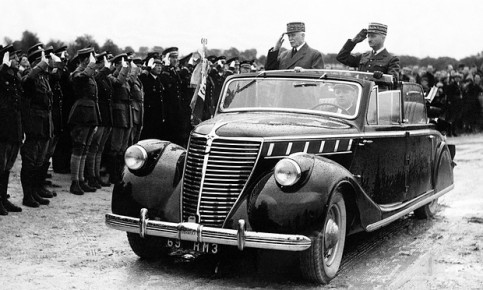The Nazi genocide serves as a warning we should heed in facing today’s crises, Snyder claims. But was Hitler’s targeting of Jews really an act of ‘ecological panic’?

We have got the Holocaust all wrong, says Timothy Snyder in his new book, and so we have failed to learn the lessons we should have drawn from it. When people talk of learning from the Nazi genocide of some six million European Jews during the second world war, they normally mean that we should mobilise to stop similar genocides happening in future. But Snyder means something quite different, and in order to lay out his case, he provides an engrossing and often thought-provoking analysis of Hitler’s antisemitic ideology and an intelligently argued country-by-country survey of its implementation between 1939 and 1945.
Hitler, Snyder correctly observes, was a believer in race as the fundamental feature of life on Earth. History was a perpetual struggle for the survival of the fittest race, in which religion, morality and secular ethics all stood in the way of the drive for supremacy. His political beliefs reduced humankind to a state of nature, sweeping aside the claims of modern science to improve the natural world. Interfering in nature, for example by improving crop yields in order to overcome the food supply deficit in Germany that had led to the deaths of half a million people during the allied blockade in the first world war, was wrong: the way to achieve this aim was to conquer the vast arable lands of eastern Europe in a parallel action to the American colonisation of the west. Both in his view were populated by inferior subhumans who should be eliminated.
Race, in Hitler’s thought, replaced the state as the most important characteristic of human society. What he wanted was anarchy, a virtually stateless society, denuded of rules, laws and ethics, that allowed the Nazis to do what they had to in the interests of the “Aryan” (ie German) race. He had already begun to achieve this in Germany itself, where the expanding world of the stormtroopers, the SS, the camps, the special courts and the Nazi party was rolling back the frontiers of the established German state and its hallowed institutions well before the war started. But it was only with the conquest of eastern Europe that Hitler had the opportunity to create a truly anarchic society in which expropriation, murder and extermination of those he considered racially inferior – Poles, Ukrainians, Belarusians and other “Slavs” – could be practised without restraint.
For Hitler, as Snyder notes, Jews fell into a different category. They were not a regional nor even a European enemy, but a universal, global one. Rather than being an inferior race they were a “non-race” or a “counter-race”, not following the laws of nature, as Slavs, Teutons, Latins and the rest of them did. Hitler’s global vision potentially targeted Jews wherever they could be found. AfterOperation Barbarossa – the invasion of the Soviet Union by the Germans and their allies on 22 June 1941 – the “task forces” or Einsatzgruppen of the SS Security Service, assisted by auxiliary police units, began shooting the Jews who lived in the areas taken by the German army: men, and very soon women and children – a million of them by the end of 1941 alone. By this time the SS had begun speeding up the process by using mobile gas vans to kill their passengers, then in the spring of 1942 much larger stationary gassing centres were opened, working on the same principle, at Belzec, Sobibór and Treblinka. Auschwitz, with its chemical poison gas, was the culmination of this process.
If the killing fields of eastern Europe could be the site of mass extermination by virtue of the abolition of the state – the Polish state, the Soviet state (in the areas conquered by the Nazis), the Estonian, Latvian and Lithuanian states – then the impact of Nazi exterminism in other countries depended largely on how far the state and its institutions had managed to survive. Thus most Jews escaped being murdered in Belgium and Denmark, where the institutions of the state, headed by the monarchy, remained largely in place, while in the Netherlands, where the monarch and the leading politicians had fled, they did not. Similarly, despite the antisemitism of the Vichy regime, most French Jews managed to survive the war.
Snyder is particularly interesting and informative when it comes to the relationship between the German occupiers and local collaborators in eastern Europe, many of whom equated the brutal Soviet oppression they had suffered with the machinations of the Jewish world-conspiracy identified by the Nazis. Some collaborators had even worked for the Soviet secret police before the Nazis came and switched their allegiance seemingly without effort. To a degree,the genocide in Ukraine could even be regarded as a “joint creation” of the invaders and the invaded.

Snyder delivers what is surely the best and most unsparing analysis of eastern European collaborationism now available, though the preceding sections on the history of Polish and Russian antisemitism are perhaps longer and more detailed than was necessary. Overlong, too, are the chapters on partisan resistance, which was important, but doesn’t deserve to take up a fifth of the entire book. And although it is better by some distance than Snyder’s previous, overpraised bookBloodlands, Black Earth shares some of the same failings as that flawed work, delivering an account of the Holocaust that is skewed far too much towards eastern Europe; it also misunderstands the ideological roots of the genocide, which, as most historians would now agree, was set in motion not as an act of revenge against an imagined Jewish world conspiracy following the failure of Operation Barbarossa in December 1941, but as an act of hubris launched the previous July, as Hitler and the leading Nazis considered the operation a resounding success.
This is not a comprehensive history of the Nazi genocide of the Jews, therefore, but a book with a thesis: and it is here that it really goes off the rails. In his concluding chapter, Snyder describes the Holocaust as an act of “ecological panic”, the belief of Hitler that the Jews were “an ecological flaw responsible for the disharmony of the planet”: nature’s harmony could only be restored through their complete elimination.
In the 21st century, he speculates, rapid and destructive climate change could lead to wholesale food shortages caused by desertification of huge areas of the planet, or alternatively drastic economic collapse and state bankruptcies. The consequences of the destruction of the state, so obvious in eastern Europe between the wars, can now be seen in Iraq and Syria. Territorial conquest and exterminatory wars might occur with increasing frequency as the condition of the Earth deteriorates. China might invade Africa. Russia has already invaded Ukraine, mindful, as Hitler was, of its rich agricultural resources. Some Muslims are starting to blame Jews and gays. American evangelical Christians decry the work of scientists. Climate change, they say, is a myth, designed like so much else to give the state greater powers. But this is just what Hitler said about the state. Far better, Snyder concludes, to use governments to slow down and eliminate climate change, reduce its harmful effects and ensure everyone has enough to eat.
Such proposals seem reasonable enough, but do they really constitute lessons we should all learn from the Holocaust? Snyder here is surely confusing Hitler’s global crusade against the Jewish “world-enemy” with his regional agenda of ensuring Germany’s food supplies, which the science of the 1930s was not capable of guaranteeing on the basis of German agricultural production alone. His speculations about possible Chinese or Russian wars of conquest driven by the need for resources are wild in the extreme. This is a pity: much of this book makes for compelling and convincing reading, but tying historical arguments to ecological nostrums in this way does not really work.

You must be logged in to post a comment Login